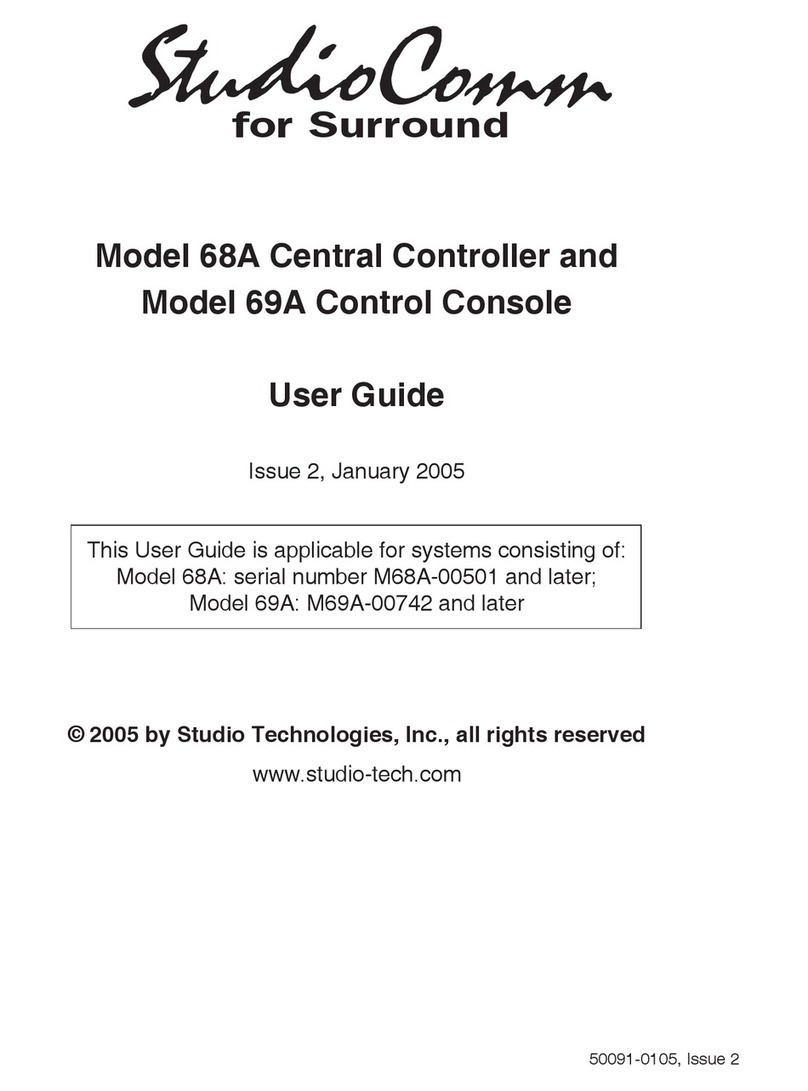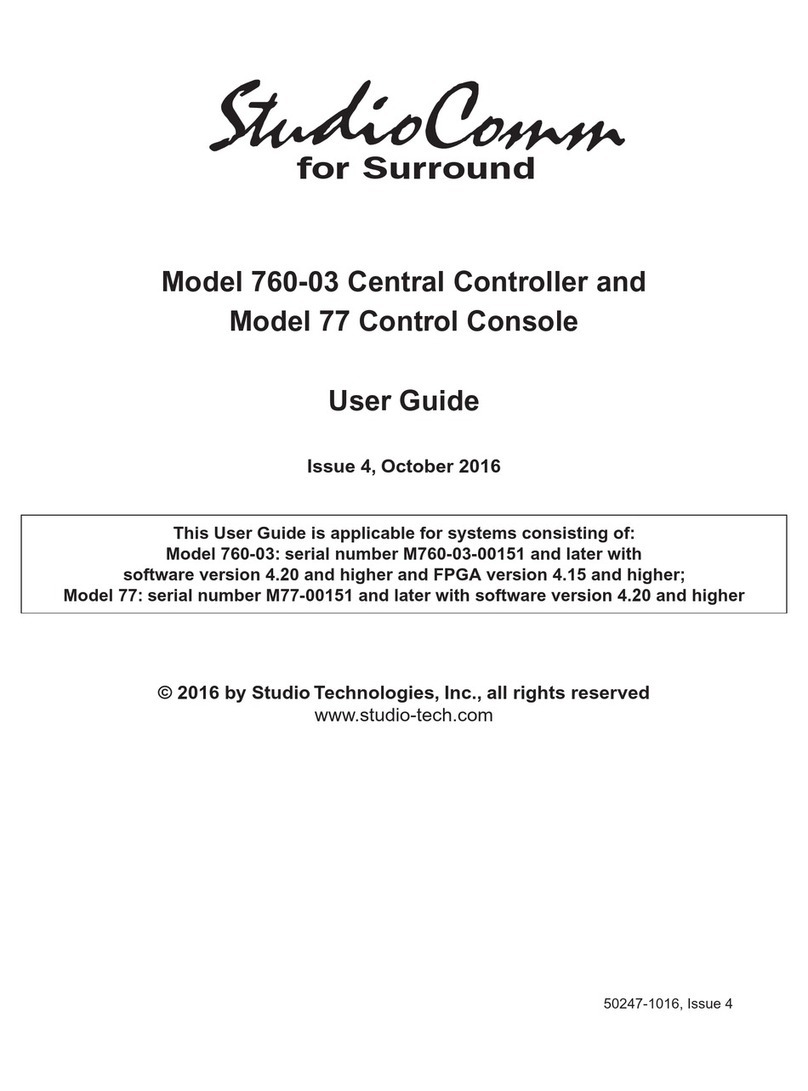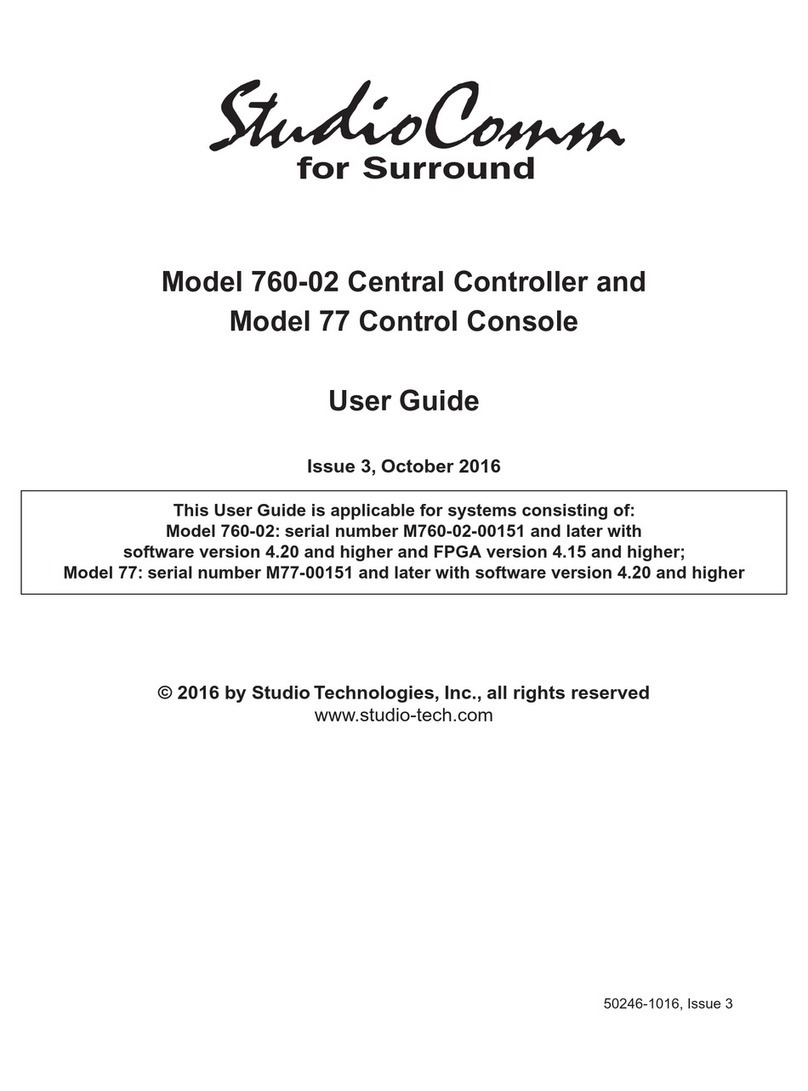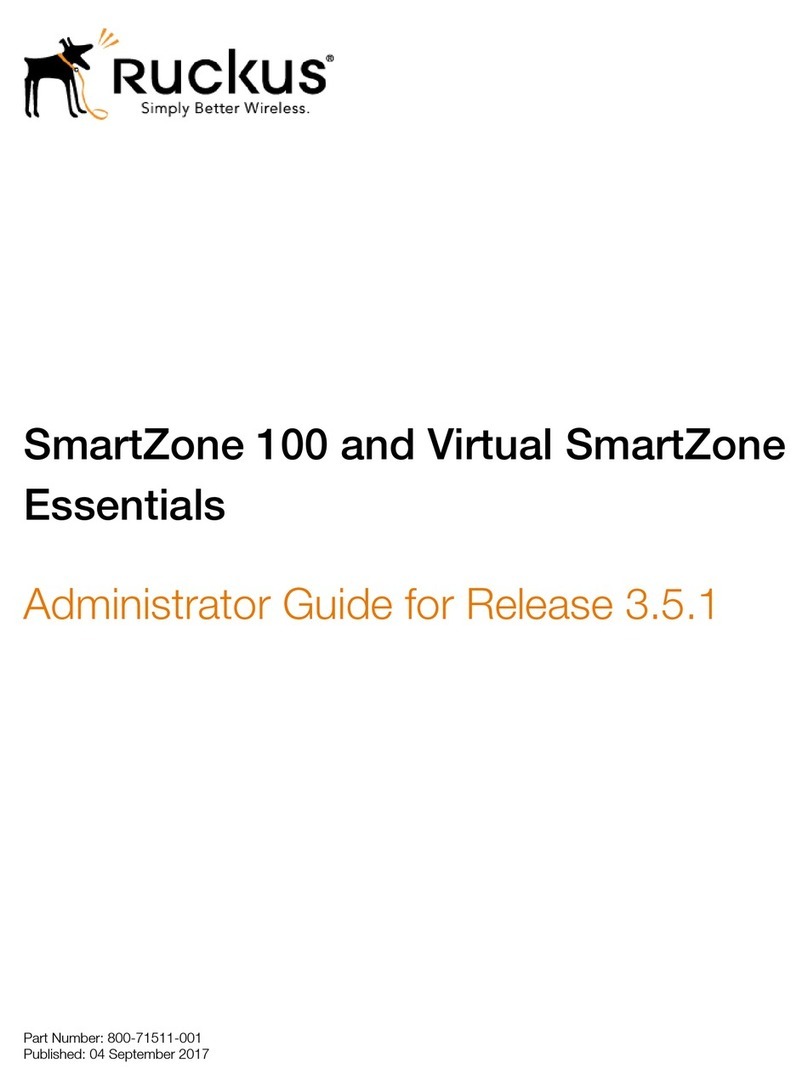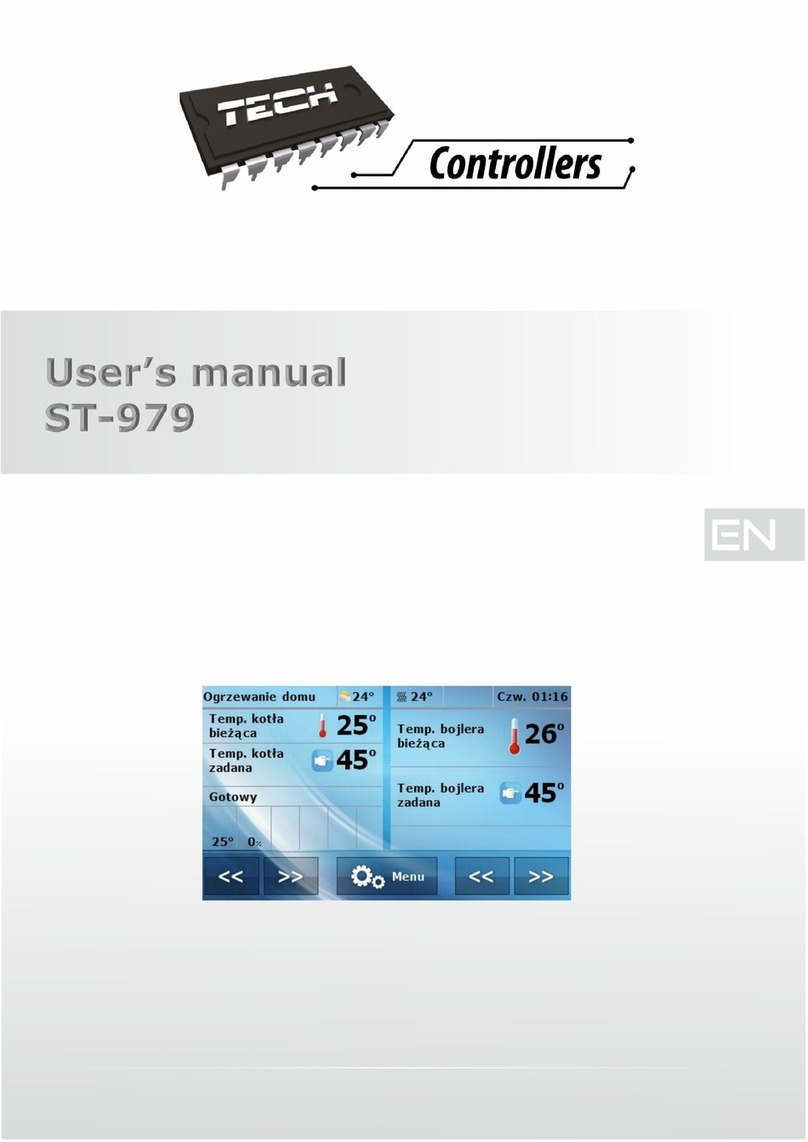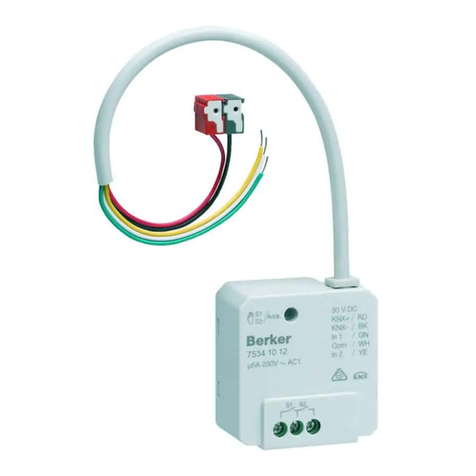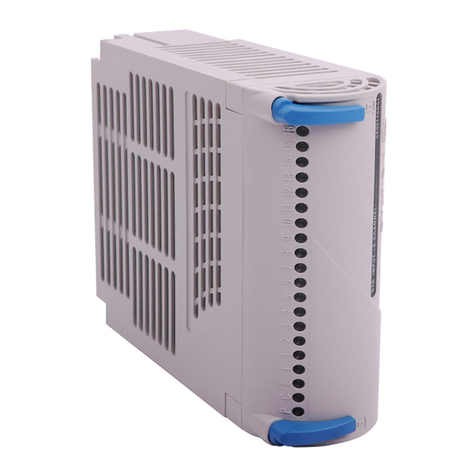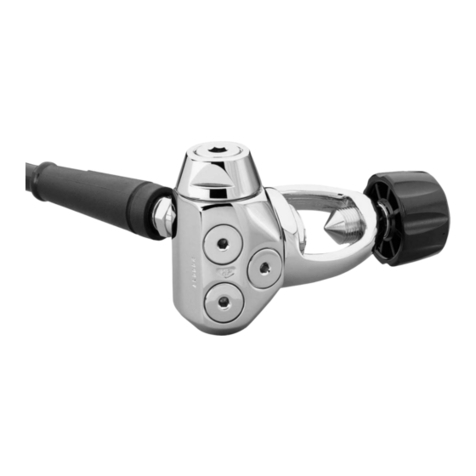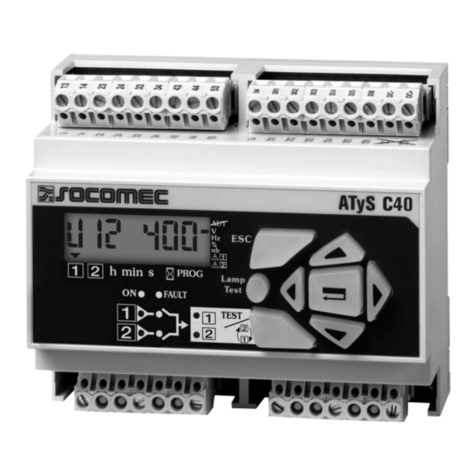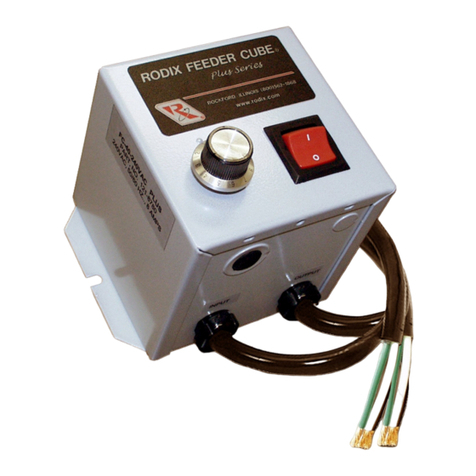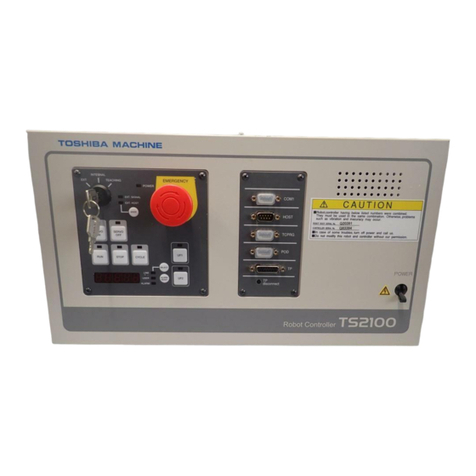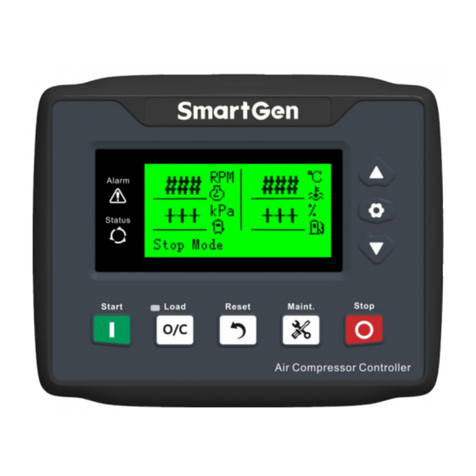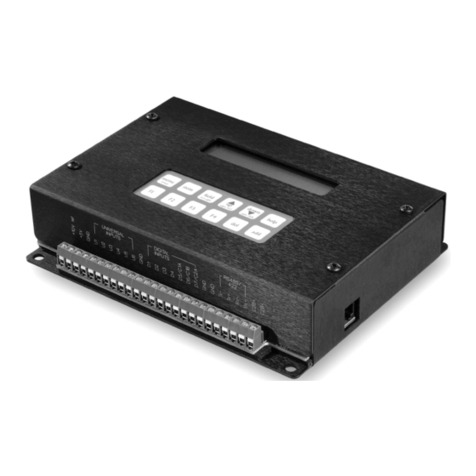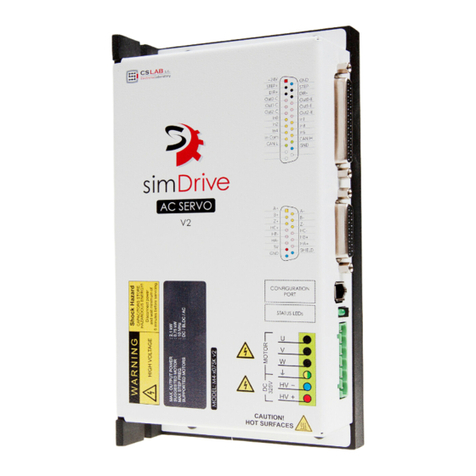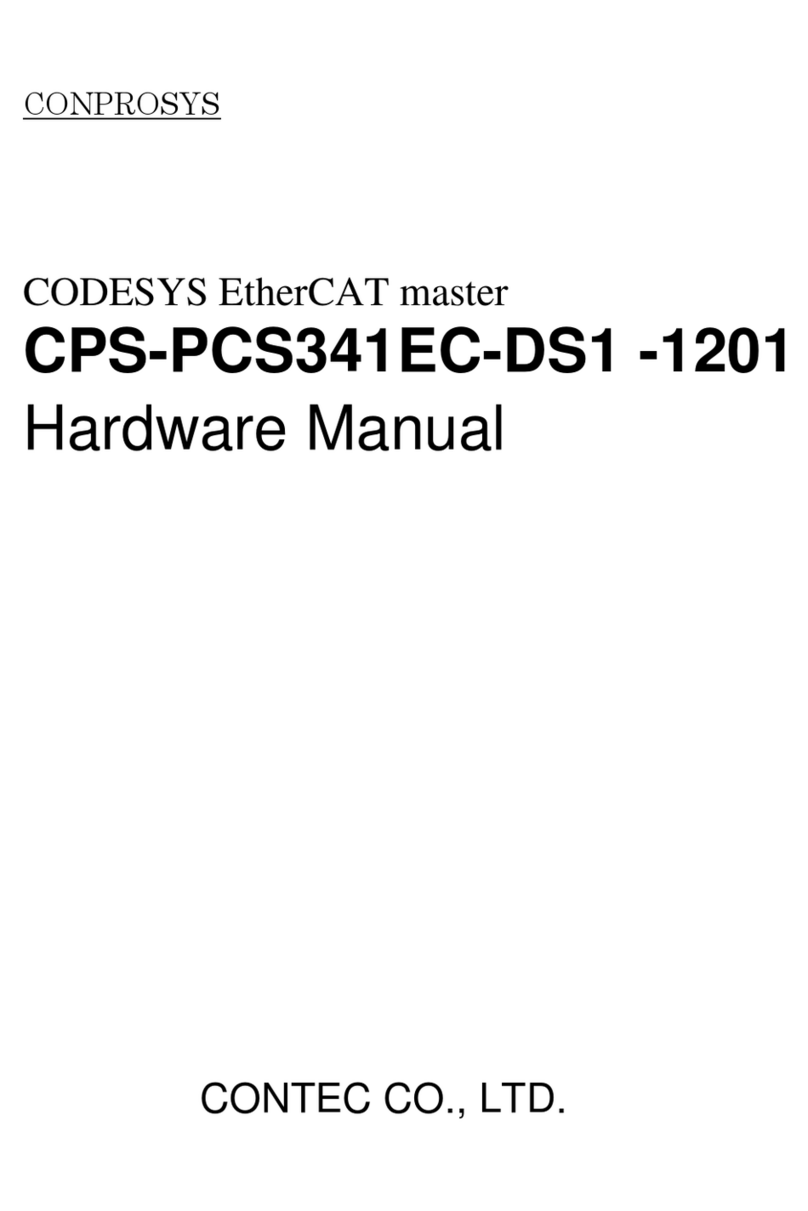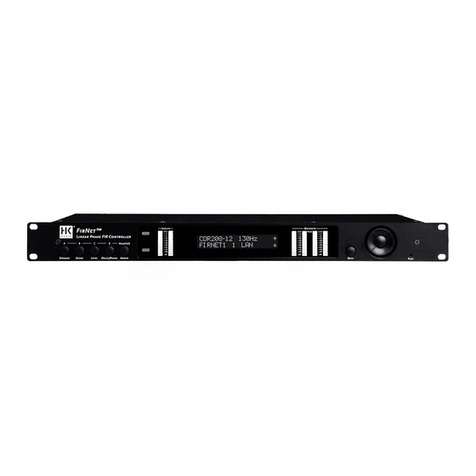StudioComm Dante 792 User manual

50396-0123, Issue 2
Copyright © 2023 by Studio Technologies, Inc., all rights reserved
studio-tech.com
User Guide
Issue 2, January 2023
This User Guide is applicable for systems consisting of:
Model 792: serial numbers M792-00151 and later with application rmware 3.00 and later;
Model 793: serial numbers M793-00151 and later with application rmware 1.04 and later
Model 792 Central Controller and
Model 793 Control Console
with Dante®Support

This page intentionally left blank.

Model 792/793 User Guide Issue 2, January 2023
Studio Technologies, Inc. Page 3
Model 792 & Model 793
StudioComm with Dante Support
Table of Contents
Revision History................................................................................................................. 4
Introduction........................................................................................................................ 5
Installation ......................................................................................................................... 9
Dante Conguration........................................................................................................... 15
Model 792 and Model 793 Conguration........................................................................... 17
Operation........................................................................................................................... 42
Technical Notes ................................................................................................................. 46
Specications .................................................................................................................... 51
Appendix A—Connection Pin-Out Charts.......................................................................... 53
Appendix B—Network Conguration Examples ................................................................ 54
Appendix C—Default Dante Channel Names.................................................................... 56
Appendix D—Factory Default Values ................................................................................ 57
Appendix E—Model 792 Control Using HTTP................................................................... 58

Issue 2, January 2023 Model 792/793 User Guide
Page 4 Studio Technologies, Inc.
Model 792 & Model 793
StudioComm with Dante Support
Revision History
Issue 2, January 2023:
• Documents removal of DNS address from Conguration menus.
• Miscellaneous corrections and clarications.
Issue 1, February 2021:
•Initial release.

Model 792/793 User Guide Issue 2, January 2023
Studio Technologies, Inc. Page 5
Model 792 & Model 793
StudioComm with Dante Support
Introduction
Dante
®
digital audio has found wide acceptance in
all aspects of audio, from live entertainment and
broadcast events, to corporate, recording, and post-
production facilities. While certainly a legacy technolo-
gy, analog audio signals have maintained an important
place in the world of professional audio. And the days
of needing to support only 2-channel stereo and 5.1
or 7.1 surround formats have ended. The variety of
surround formats, and their associated channel counts
and arrangements, has expanded the need for spe-
cialized equipment. The ability to monitor these Dante
digital and analog audio sources in a convenient and
sonically excellent way has become a requirement
for many applications. Studio Technologies has
addressed these needs with the StudioComm with
Dante Support system consisting of the Model 792
Central Controller and the Model 793 Control Console.
Rather than supporting a specic surround format,
the StudioComm with Dante Support system incor-
porates an internal 16-channel architecture. This
allows a range of surround audio applications to be
easily supported. With Dante digital and analog audio
inputs, Dante digital and analog monitor outputs, and
an extensive set of operating resources it’s a simple
task to integrate a monitoring system into virtually any
contemporary facility. The carefully selected group
of features, including both 16-channel surround and
2-channel stereo inputs, configurable input-signal
time delays, multiple pre- and post-fader outputs, and
mute/solo functions make the system powerful yet
simple to operate. And by using the best of contempo-
rary technology, as well as following rigorous design
practices, the system’s audio quality is excellent.
A StudioComm with Dante Support system starts
with the Model 793 Control Console. It’s the sys-
tem’s “command center” and is designed to reside at
a user’s location, allowing ngertip selection of all
monitoring functions. Numerous LED indicators
provide complete status information. A backlit OLED
display indicates key operating and configuration
parameters. The second part of the StudioComm
system is the Model 792 Central Controller. This
one-rack-space unit contains all the circuitry required
to support the Dante digital and analog audio input
and output signals. It links with the Model 793 using
a 9-conductor D-subminiature cable. An integral web
server allows fast and exible conguration of the
unit’s networking, audio, and Dante performance. This
allows the system’s performance to be optimized to
meet the needs of many specic applications.
Dante audio resources include both surround and
stereo inputs and outputs. The Dante surround
input and output functions consist of 16 independent
channels while the stereo input and output functions
support two channels. The Dante channels are
Figure 1. Model 792 Central Controller front view
Status LEDs
AC Mains
Input
Figure 2. Model 792 Central Controller back view
3.5 mm
Jack
DC
Input
Analog
Surround
Outputs
Analog
Surround
Inputs
To/From
Control
Consoles
Ethernet
Ports
USB
Port
Level
Control
Signal
Present
LEDs

Issue 2, January 2023 Model 792/793 User Guide
Page 6 Studio Technologies, Inc.
Model 792 & Model 793
StudioComm with Dante Support
compatible with AES67 and support Dante’s ST 2110
implementation. Analog audio resources include a
16-channel surround input, a 2-channel stereo input,
and a 16-channel surround output.
Great care was taken in designing the system’s cir-
cuitry, ensuring that the character of the Dante digital
and analog audio input signals is preserved. All audio
processing is performed in 32-bit logic using a high-
speed eld-programmable-gate-array (FPGA) inte-
grated circuit. The performance of the analog-to-digital
and digital-to-analog functions will meet or exceed
virtually any professional audio product. The sonic
performance of the StudioComm system is completely
“pro” with no compromises.
The Model 792 Central Controller occupies one space
(1U) in a standard 19-inch rack. Dante digital audio
sources are interfaced using one or two gigabit (GigE)
Ethernet network connections that use RJ45 connec-
tors. This arrangement allows switched or redundant
Dante operation. A third gigabit network connection
provides an independent means of accessing the
Model 792’s conguration webpages. This ensures
that facilities can support separate audio and main-
tenance networks. Standard connectors on the Model
792 allow simple interfacing with Dante digital audio,
analog audio, control console, and power connec-
tions. AC mains power is connected directly to the
Model 792, with an acceptable range of 100 to 240 V,
50/60 Hz. A source of nominal 12 volts DC can also be
connected. If both power sources are connected the
AC mains source will provide operating power while
the DC source serves as a “hot standby.”
Two Surround and Two Stereo
Inputs
The Model 792 allows connection of one Dante digital
surround and one analog surround signal source.
Each surround input allows up to 16 independent
channels to be supported with no dened format. This
provides exibility for installations that utilize formats
such as 7.1, 7.1.2, 7.1.4, 10.2, 11.1, 11.1.4, etc. Each
of the 16 channels associated with a surround input
is full-delity and, as such, is appropriate to use as
a main, surround, back, side, ceiling, or low-frequency
enhancement channel. This exibility allows the Model
792 to be utilized in a variety of applications, including
experimental or test formats.
Support for two 2-channel stereo inputs is also provid-
ed. A Dante stereo input allows two channels of Dante
audio to be selected for monitoring. An unbalanced
analog input, located on the Model 792’s front panel,
allows the output of a “semi-pro” personal audio de-
vice to be directly connected.
The audio performance of the Model 792’s analog
inputs is very good. Low-noise, wide dynamic-range
circuitry ensures that the audio quality is preserved.
The analog audio signals are routed to high-perfor-
mance analog-to-digital conversion (ADC) circuitry
that supports a bit depth of 24 and sample rates of
44.1, 48, and 96 kHz. A precision voltage-reference
circuit helps the ADC circuitry perform highly accurate
signal conversion. The audio signals, now in the digital
domain, are routed to a high-speed programmable
logic (FPGA) device where they are mixed and level-
controlled as necessary.
Each of the four inputs, two surround and two stereo,
can have a unique name assigned to it. This can be
helpful when a Model 793 Control Console user is se-
lecting which input to monitor. In addition, a time delay
can be applied to each input, useful for compensating
for video processing or display “latency.” Delays of
up to 999 milliseconds, as related to a sample rate
of 48 kHz, can be applied. Each input channel, 36 in
total, can be level “trimmed” over a ±20 dB range in
steps of 0.1 dB.
Figure 3. Model 793 Control Console front view

Model 792/793 User Guide Issue 2, January 2023
Studio Technologies, Inc. Page 7
Model 792 & Model 793
StudioComm with Dante Support
Analog Surround Input
The Model 792 provides 16 independent analog
input channels which are compatible with balanced
or unbalanced line-level sources. These inputs have
a nominal level of +4 dBu and are electronically
balanced (dierential), capacitor-coupled, and ESD
(static) protected for reliable operation in demanding
applications. Extensive ltering minimizes the chance
that radio frequency (RF) energy will cause interfer-
ence. The analog inputs are protected from dam-
age should a moderate DC voltage be accidentally
connected. These characteristics make the analog
inputs suitable for use in studio and mobile facility
environments. The analog input signals are convert-
ed to 24-bit digital and then utilized by the internal
logic circuitry. Compatible signal sources include
audio consoles, broadcast playback equipment, and
analog output ports on routers and networked audio
equipment.
Dante Surround Input
The Model 792 provides a 16-channel “wide” Dante
input for direct interfacing with applications that utilize
Dante technology. As with the Analog Surround Input,
the format of the 16 input channels is not dened.
Signals with a bit depth of up to 24 and sample rate
of 44.1, 48, or 96 kHz are compatible. The Dante
surround input channels have a nominal signal level
of –20 dBFS.
Analog Stereo Input
A 3-conductor 3.5 mm jack is located on the Model
792’s front panel and allows direct interconnection
with the output of a personal audio device. The input
circuitry is optimized for use with “semi-pro” equip-
ment that has a nominal level of –10 dBu. A rotary
level control and two signal-present LEDs enable a
user to easily optimize the sensitivity of the input cir-
cuitry, matching its performance to the nominal level
of the connected source. A high-performance ADC
circuit converts the analog signal to 24-bit digital.
Dante Stereo Input
The Model 792 provides two Dante digital audio input
channels for interfacing with a stereo source. As with
the Dante Surround Input, the Dante Stereo Input
has a nominal level of –20 dBFS, a bit depth of up to
24, and sample rate support of 44.1, 48, and 96 kHz.
Three Monitor Outputs
The StudioComm with Dante Support system pro-
vides three monitor outputs: one 16-channel Dante
digital, one 16-channel analog, and one 2-channel
stereo Dante digital. Conguration choices allow the
characteristics of the three outputs to be optimized
to meet the requirements of specific applications.
For exibility, a conguration menu choice allows the
level of each analog output channel to be individu-
ally adjusted (“trimmed”) over a range of ±20 dB in
0.1 dB steps.
Analog Output
The Analog Surround Output is 16 channels “wide”
and can be selected for pre- or post-fader (before
or after the level control) operation. These analog
output channels are intended for connection to inputs
on audio ampliers or powered loudspeakers associ-
ated with a monitor loudspeaker system. Power-up/
power-down muting relays help to protect the loud-
speaker system from unwanted transient signals.
The analog surround output channels have a nominal
level of +4 dBu and are electronically balanced, capac-
itor-coupled, and ESD (static) protected. High-quality
components, including the critical digital-to-analog
converters, are used to provide low-distortion, low-
noise, and sonically excellent performance. Robust
circuitry provides protection from damage should
a moderate DC voltage be accidentally connected,
something especially useful in broadcast applications.
The analog outputs are compatible with virtually all
balanced and unbalanced loads with an impedance
of 2 k ohms or greater.
The Model 792’s analog output channels have a max-
imum level of +24 dBu. This allows both compatibility
and signicant headroom in applications where digital
audio input signals with a nominal level of –20 dBFS
need to be converted into analog signals that have a
nominal level of +4 dBu.
Dante Surround and Stereo Outputs
The Model 792 provides two Dante monitor outputs.
One is 16 channels and the other is 2-channel ste-
reo. Each is selectable to be either pre- or post-fader
and can be routed (Dante subscribed) to inputs on
compatible monitor loudspeakers. They can also be
utilized for level metering or other general-purpose
uses, typically configured for pre-fader operation.

Issue 2, January 2023 Model 792/793 User Guide
Page 8 Studio Technologies, Inc.
Model 792 & Model 793
StudioComm with Dante Support
The nominal level of the Dante monitor outputs is
–20 dBFS. Each Dante output channel can have its
level individually adjusted (“trimmed”) over a range of
±20 dB with a step size of 0.1 dB.
Dante Performance
Two of the Model 792’s three gigabit Ethernet ports
are utilized by the Dante audio interfaces. These ports
can be selected, using the Dante Controller software
application, for switched or redundant Dante opera-
tion. Support is provided for both AES67 and Dante
Domain Manager™ (DDM) operation. The Model 792
will also support Dante’s ST 2110 implementation.
The StudioComm with Dante Support system allows
the Dante audio sample rate to be selected for 44.1,
48, or 96 kHz with a bit depth of 24. The Dante Con-
troller software application is used to route (subscribe)
the Model 792’s receiver (input) and transmitter
(output) channels with the associated Dante compli-
ant-equipment.
Operation
The Model 793 Control Console provides the operator
with an easy-to-use interface and includes a set of
pushbutton switches, a rotary control, and a backlit
OLED graphics display. Together these resources are
used to select the desired monitoring environment.
User functions include selecting the input source,
adjusting the listening level, selecting the monitor
output, and activating other special features. The
four audio inputs, two 16-channel surround and two
2-channel stereo, can be individually selected for
monitoring. Although only one is typically selected to
be monitored at any one time, for exibility two, three,
or all four can be combined (summed) and monitored.
The rotary control (actually an encoder with 30 steps
per rotation) allows adjustment of the monitor output
level in 0.5-dB steps.
For content conrmation, each of the unit’s sixteen
channels can be individually muted or soloed as de-
sired. Multiple channels can also be simultaneously
muted or soloed and needed. A reference level value
can be saved and then enabled by the operator, al-
lowing the monitor output level to be directly returned
to a known value. A mute all function simultaneously
mutes all sixteen output channels. The dim feature al-
lows the operator to attenuate the monitor output level
from among four congurable values. The graphics
display will show a variety of system-related infor-
mation. This includes the text names that have been
assigned to the input sources and output destinations.
The display will also show the current monitor output
level directly in dB. Pressing the rotary control’s knob
will cause the management port’s IP address to show,
helpful when conguring the StudioComm with Dante
Support system.
LED indicators are provided on both the front and back
panels of the Model 792. These relate to selected
performance characteristics of the Ethernet interfaces,
Dante interface, general system activity, and levels of
the unbalanced stereo audio input. They can be useful
during installation, troubleshooting, and operation of
the StudioComm system.
Special applications can take advantage of the Model
792 Central Controller’s ability to be controlled using
an API running under an operating system on ex-
ternal computer hardware. Using HTTP, in the form
of sending GET or POST HTTP requests, all Model
793 Control Console user control functions can be
duplicated using a software-based application. These
HTTP requests will interface with the Model 792 by
way of the management Ethernet interface.
Simple Installation
The Model 792 Central Controller uses standard con-
nectors to allow fast and convenient interconnections.
Gigabit Ethernet connections are made to local area
network (LAN) ports using three RJ45 connectors, two
for Dante and one for management. Multiple LEDs on
the unit’s back panel display the status of the network
connections. Four 25-pin female D-subminiature
connectors are used to interface with the unit’s 16
channels of analog surround input and 16 channels
of analog monitor output. A 3-conductor 3.5 mm
jack, located on the Model 792’s front panel, allows
connection of a source of unbalanced stereo audio.
A detachable power cord is used to connect the
Model 792 to a source of AC mains power. A DC
power source can be connected using a 4-pin XLR
connector. The lightweight aluminum enclosure
mounts in one space (1U) of a standard 19-inch rack
enclosure. An interconnecting cable with 9-pin male
D-subminiature plugs on each end are used to inter-
connect the Model 792 Central Controller with the
Model 793 Control Console. An interface cord with an

Model 792/793 User Guide Issue 2, January 2023
Studio Technologies, Inc. Page 9
Model 792 & Model 793
StudioComm with Dante Support
approximate length of 20 feet (7.3 meters) is includ-
ed with each StudioComm system. The standalone
Model 793 Control Console is typically placed on a
surface that allows easy operator access.
AC and DC Power
The Model 792 allows an AC mains source of 100-
240 V, 50/60 Hz to be connected by way of a de-
tachable power cord. The unit can also be powered
using a 12 volts DC source that is connected via a
broadcast-standard 4-pin XLR connector. If both the
AC and DC power sources are connected the Model
792 will be powered by the AC mains supply. Only if
the AC mains source fails will a load be placed on the
DC source. The Model 792 Central Controller provides
a current-limited source of 12 volts DC power for use
by the Model 793 Control Console.
Future Capabilities and Firmware
Updating
Both the Model 792 and Model 793 were designed
so that their capabilities can be easily enhanced in
the future. A USB connector, located on the Model
792’s back panel, allows its main and FPGA rmware
(embedded software) to be updated using a USB
ash drive. The Model 792 uses Audinate’s Brook-
lyn module to implement its Dante connectivity. The
rmware in this module can be updated via the unit’s
Ethernet connections, helping to ensure that the
Dante capabilities remain up to date. The Model 793
also utilizes a USB connector, located inside the unit,
to allow its main rmware to be updated. All rmware
les and conguration parameters are securely stored
in non-volatile memory.
Installation
In this section, the Model 792 Central Controller will
be mounted in one space (1U) of an equipment rack.
Ethernet data connections will be made. Some appli-
cations will require analog audio input and/or output
signals be interconnected. A location will be selected
for the Model 793 Control Console and it will be inter-
connected with the Model 792. AC mains and/or DC
power will be connected to the Model 792.
Up to three Gigabit Ethernet data connections will be
made to the Model 792 using standard RJ45 patch
cables. Connections can be made to the Analog
Surround Output using two 25-pin D-subminiature
connectors. If needed for the application, line-level
Analog Surround Input connections will be made using
two additional 25-pin D-subminiature connectors. A
3-conductor 3.5 mm jack, located on the front panel,
is provided for interconnection with a source of ste-
reo analog audio. It will typically remain available for
temporary use by a personal audio device, however
a permanent connection can be made.
AC mains power can be connected to the Model 792
by means of a detachable cord set that is compatible
with the unit’s 3-pin IEC 320 C14 inlet connector.
Some applications may warrant connection to a
source of nominal 12 volts DC which can be made
by way of a 4-pin XLR connector. The DC source can
be used to power the Model 792 or it can serve as a
backup power source should AC mains be connected.
What’s Included
The shipping carton contains one each of the follow-
ing: Model 792 Central Controller, Model 793 Control
Console, 9-pin D-subminiature interconnecting cable
(approximately 20 feet (6 meters) in length), and
instructions on how to obtain an electronic copy of
this guide. Also included in the shipping carton is a
North-American-standard AC mains cord. For desti-
nations outside of North America the local reseller or
distributor should provide an appropriate AC mains
cord.
Mounting the Model 792
The Model 792 Central Controller requires one space
(1U) in a standard 19-inch (48.3 cm) equipment rack.
Secure the Model 792 into the equipment rack using
two mounting screws per side. As the Model 792 does
not contain a fan or other noise-producing source it
can be located within a room or other structure where
audio monitoring is going to take place. Select a loca-
tion that is convenient for making connections to the
Ethernet interfaces, analog audio outputs and inputs,
and interfacing with the Model 793 Control Console.
Twisted-pair (UTC) Ethernet has a 100-meter (325-
foot) interconnection cable limitation. But that can
be overcome by using a ber-optic interconnection
between the Model 792 and the Ethernet switch or
switches in the one or more associated local-area-
networks (LANs). A 3-conductor (stereo) 3.5 mm
jack is located on the Model 792’s front panel. This
allows direct connection of an analog source provided
by a personal audio device. Selecting a location for

Issue 2, January 2023 Model 792/793 User Guide
Page 10 Studio Technologies, Inc.
Model 792 & Model 793
StudioComm with Dante Support
the Model 792 that allows ready access to this jack
can be helpful in some applications. A cable is sup-
plied for interconnecting the Model 792 with the Model
793. If the needs of a specific installation dictate,
an alternate-length interconnecting cable can be
fabricated and used.
Ethernet Connections
The Model 792 provides three Gigabit (GigE) Ethernet
ports for exibility and compatibility with many net-
working implementations. Two ports are provided for
interconnections with one or two local area networks
(LAN) associated with Dante audio-over-Ethernet net-
working schemes. They are labeled as PRI (primary)
and SEC (secondary). Using the Dante Controller ap-
plication these ports can be congured for Switched or
Redundant Dante operation. The third Ethernet port,
labeled MGMT, is dedicated to accessing the Model
792’s management resources. An internal web server
function supports the Model 792’s management port’s
webpages. These webpages are used for congura-
tion, monitoring, and maintenance of Model 792 and
Model 793 operation.
By providing three Ethernet ports the Model 792
allows support for facilities that utilize independent
networks for Dante audio transport and equipment
management. In this way, “production” networks that
support transport of audio signals by way of a single
LAN (for Switched Dante) or two LANs (for Redundant
Dante) can be separate from an engineering network
that is used by technical personnel for conguring and
maintaining a facility or “plant.”
Connections to the three Ethernet interfaces are made
by way of standard RJ45 connectors (jacks) that are
located on the back of the Model 792’s enclosure. The
Ethernet interfaces support auto MDI/MDI-X so that
crossover cables are not required.
Refer to Appendix B for examples of how the Model
792’s three Ethernet interfaces might be utilized.
Dante Port Connections
At least one 1000BASE-T (GigE) Ethernet connec-
tion is required for Model 792 Dante operation. It
should be connected to the primary RJ45 jack. A
second 1000BASE-T connection can be made to the
secondary RJ45 jack if Redundant Dante is desired.
(For this functionality to be active the Model 792’s
network configuration must be set for Redundant
within the Dante Controller software application.)
While technically 100BASE-TX Ethernet can also be
used for these Dante connections, it is not optimal.
Additionally, it’s important to note that 10BASE-T
Ethernet connections are not sucient.
When congured in Dante Controller for the Switched
network mode the Model 792’s secondary Dante Eth-
ernet connection can also be used as a “loop through”
port such as would be provided by an Ethernet switch.
Switched mode is the default setting but using the
secondary Dante port in this manner for applications
other than troubleshooting or “looping” to access the
Model 792’s management port is not recommended.
It will function reliably but “daisy chaining” Ethernet
signals can limit exibility and present a failure point;
it’s optimal if each Dante Ethernet interface connects
directly to a separate port on an Ethernet switch.
Management Port Connection
An Ethernet signal is required to be interconnected
with the management port so that Model 792 con-
guration and management can be performed. It’s
recommended that a 1000BASE-T (GigE) connection
be made but a 100BASE-TX or even a 10BASE-T
connection is sucient. (GigE will provide the best
performance and it’s assumed that all contemporary
applications will support it.) The Model 792’s man-
agement port can share a network that is being used
by the unit’s one or two Dante network connections.
Refer to Appendix B for examples of how this can be
easily implemented.
Dante and Analog Audio
The Model 792 provides both Dante digital and ana-
log audio output signals. In most cases, the Analog
Surround Output channels will be configured for
Figure 4. Detail of Model 792 back panel showing the
Ethernet port’s RJ45 jacks

Model 792/793 User Guide Issue 2, January 2023
Studio Technologies, Inc. Page 11
Model 792 & Model 793
StudioComm with Dante Support
post-fader operation and connected to inputs on
ampliers or amplied speakers. The Analog Surround
Output can also be congured for pre-fader opera-
tion. Dante Surround and Dante Stereo Outputs are
also provided. They too can be congured for pre-
or post-fader operation. Surround and stereo audio
inputs are available in both Dante digital and line-level
analog formats. These output and input resources
allow a combination of Dante digital and analog
connections to be made so as to best support a wide
range of specic applications.
Analog Audio Connections
Connecting analog signals to and from the Model
792 are made by way of four 25-pin female D-sub-
miniature (DB-25F) connectors and one 3-conductor
3.5 mm jack. Two of the D-sub connectors are asso-
ciated with the Analog Surround Output channels; the
other two D-subs are used by the Analog Surround
Input channels. The 3.5 mm jack is provided for inter-
connecting with a stereo analog audio source typically
provided by a personal audio device. Refer to Figures
1 and 2 for a view of the 3.5 mm connector on the
front and the D-sub connector on the back.
Analog Surround Output
Two 25-pin female D-subminiature connectors (DB-
25F), labeled Analog Surround Output Channels 1-8
and Analog Surround Output Channels 9-16, are
located on the Model 792’s back panel. They pro-
vide access to the sixteen Analog Surround Output
channels. These outputs are electronically balanced
and will perform optimally when driving loads of
2 k (2000) ohms or greater. In most situations, these
outputs will be connected to inputs on audio ampliers
associated with monitor loudspeakers or to the inputs
of loudspeakers that contain integrated amplifiers
(“amplied speakers”).
The wiring scheme used by the D-subminiature con-
nectors comply with AES59-2012, as made popular
by TASCAM. Wiring assemblies prepared for use with
the Model 792’s Analog Surround Output channels
should be identical to that of TASCAM-type output
assemblies. Refer to Figures 6 and 7 or Appendix A
for the exact connection details. But note that unlike
TASCAM-type assemblies, the Model 792’s D-sub
connectors use “locking” screws with 4-40 threads.
In most applications, 3-pin male XLR connectors will
be used to interface with the inputs on the associated
ampliers or amplied speakers. In this case, a Model
792 monitor output channel’s + terminal would go to
pin 2 of the XLR, the – terminal to XLR pin 3, and the
shield terminal to XLR pin 1. Balanced connection of
the Analog Surround Output channels is the preferred
connection method but unbalanced operation does
not pose a problem. To connect to an unbalanced
input, connect the + terminal as signal high, and only
the Model 792’s shield terminal as the signal low/
shield. Leave the – terminal unconnected. For correct
unbalanced operation it is important not to connect
the – terminal and shield together.
Figure 5. Detail of Model 792 back panel showing
the Analog Surround Output Channels
Channel High (+) Low (–) Shield
1 24 12 25
2 10 23 11
3 21 9 22
4 7 20 8
5 18 6 19
6 4 17 5
7 15 3 16
8 1 14 2
Notes:
1) Connector type is 25-pin female D-subminiature (DB-25F).
Installer must provide male (DB-25M). Connector uses 4-40
threaded inserts for locking with mating plug.
2) Wiring scheme follows AES59-2012 convention. Standard
TASCAM-type wiring harnesses are typically compatible
(locking hardware requires 4-40 screw threads).
Figure 6. Connections for Analog Surround Output
Channels 1-8

Issue 2, January 2023 Model 792/793 User Guide
Page 12 Studio Technologies, Inc.
Model 792 & Model 793
StudioComm with Dante Support
How the Analog Surround Output functions will de-
pend on its conguration. When its source is selected
for pre-fader the sixteen output channels will have
a xed nominal level of +4 dBu. When selected for
a post-fader choice the output level of the Analog
Surround Output channels will depend on the setting
of the level control located on the Model 793 Control
Console. When the level trim conguration param-
eters are set for 0 dB and the level control is at its
maximum value (0 on the display) the input-to-output
signal path will be at unity gain; no gain or attenuation
will impact the signal.
A level trim conguration selection in one of the Model
792’s management webpages allows adjustment of
the signal level of each individual channel over a –20.0
to +20.0 dB range. This will ensure that the Analog
Surround Output channels can be compatible with
audio signals and equipment that have a wide range
of nominal levels. In some cases, the output level
might benet from being reduced, such as by 10 dB,
rather than having gain added.
Analog Surround Input
Two female 25-pin D-subminiature (DB-25F) connec-
tors, located on the Model 792’s back panel, are used
to connect with up to sixteen channels of line-level
analog audio associated with a surround source. The
connectors are labeled Analog Surround Input Chan-
nels 1-8 and Analog Surround Input Channels 9-16.
Refer to Figures 9 and 10 or Appendix A for details
on the exact pinout of these D-sub connectors. The
wiring scheme used by the D-subminiature connec-
tors comply with AES59-2012, as made popular by
TASCAM. A wiring assembly prepared for use with the
Analog Surround Input channels would be identical
to a standard TASCAM-type input assembly with the
exception of using “locking” screws with 4-40 threads.
Each Analog Surround Input circuit is electronically
balanced and optimized for connection to a balanced
or unbalanced source with a nominal signal level of
+4 dBu. A conguration selection in one of the Model
792’s management webpages allows adjustment
of the input gain of each individual channel over a
–20.0 to +20.0 dB range. This will allow the inputs
to be made compatible with audio signals that have
a wide range of nominal levels. When connecting
a consumer-level (“–10 dBV”) audio source adding
12 dB of gain to each input might be effective. In
some legacy applications, adding 10 dB of gain to an
input channel associated with a low-frequency-
enhancement (LFE) channel may be appropriate.
Balanced analog sources should be wired so that sig-
nal high is connected to +, signal low to –, and shield
to the shield connection. With an unbalanced source,
connect signal high to the + connection, and shield to
both the – and the shield connections. If connecting to
an unbalanced analog source in this manner results
in hum or noise try connecting signal high to + and
shield to –; leave the shield connection unterminated.
Channel High (+) Low (–) Shield
9 24 12 25
10 10 23 11
11 21 9 22
12 7 20 8
13 18 6 19
14 4 17 5
15 15 3 16
16 1 14 2
Notes:
1) Connector type is 25-pin female D-subminiature (DB-25F).
Installer must provide male (DB-25M). Connector uses 4-40
threaded inserts for locking with mating plug.
2) Wiring scheme follows AES59-2012 convention. Standard
TASCAM-type wiring harnesses are typically compatible
(locking hardware requires 4-40 screw threads).
Figure 7. Connections for Analog Surround Output
Channels 9-16
Figure 8. Detail of Model 792 back panel showing
the Analog Surround Input Channels
Analog Stereo Input
A 3-conductor (stereo) 3.5 mm jack and associated
rotary potentiometer are located on the Model 792’s
front panel. Together they allow direct interfacing with
a source of analog stereo audio, typically provided by
a personal audio device. The input circuit’s nominal

Model 792/793 User Guide Issue 2, January 2023
Studio Technologies, Inc. Page 13
Model 792 & Model 793
StudioComm with Dante Support
level is –10 dBu, but the potentiometer will allow
sources with a nominal level moderately lesser or
greater than –10 dBu to be eectively utilized.
In most cases, the 3.5 mm jack will be left untermi-
nated allowing a temporary connection to be made.
However, there’s no reason why a permanent con-
nection can’t be made. The interconnecting cable’s
3-conductor 3.5 mm plug should be wired such that
left channel audio is on the tip lead, right channel
audio is on the ring lead, and audio shield/common is
on the sleeve lead. Refer to Figure 12 for connection
details.
A conguration selection in one of the Model 792’s
management webpages allows adjustment of
the input gain of each channel over a –20.0 to
+20.0 dB range. In most cases, changing the trim
value to something other than 0 will not be necessary.
Channel High (+) Low (–) Shield
1 24 12 25
2 10 23 11
3 21 9 22
4 7 20 8
5 18 6 19
6 4 17 5
7 15 3 16
8 1 14 2
Notes:
1) Connector type is 25-pin female D-subminiature (DB-25F).
Installer must provide male (DB-25M). Connector uses 4-40
threaded inserts for locking with mating plug.
2) Wiring scheme follows AES59-2012 convention. Standard
TASCAM-type wiring harnesses are typically compatible
(locking hardware requires 4-40 screw threads).
Figure 9. Connections for Analog Surround Input
Channels 1-8
Channel High (+) Low (–) Shield
9 24 12 25
10 10 23 11
11 21 9 22
12 7 20 8
13 18 6 19
14 4 17 5
15 15 3 16
16 1 14 2
Notes:
1) Connector type is 25-pin female D-subminiature (DB-25F).
Installer must provide male (DB-25M). Connector uses 4-40
threaded inserts for locking with mating plug.
2) Wiring scheme follows AES59-2012 convention. Standard
TASCAM-type wiring harnesses are typically compatible
(locking hardware requires 4-40 screw threads).
Figure 10. Connections for Analog Surround Input
Channels 9-16
Figure 11. Detail of Model 792 front panel showing
analog stereo input
Figure 12. Connections for mating plug compatible
with the Analog Stereo Input 3.5 mm receptacle
Connecting the Model 792 to the
Model 793
A 9-pin female D-subminiature connector (DE-9F),
labeled To/From Control Consoles, is provided
on the back panel of the Model 792 Central Control-
ler. This is used to interface the rack unit with the
Model 793 Control Console. Refer to Figure 14 or
Appendix A for details. A cable with 9-pin male D-sub
(DE-9M) connectors on each end is used to inter-
connect the Model 792 with the Model 793. A cable,
approximately 20 feet (6 meters) in length, is included
in the shipping carton. This cable implements all nine
connector pins in a one-to-one manner.
Should an interconnecting cable of a dierent length
be required there’s no problem for one to be fabricat-
ed and used. While it can be wired in a one-to-one
fashion supporting all nine pins, only four connections
are actually required: pin 1 (data+), pin 6 (data–),
pin 4 (DC+), and pin 9 (DC–).

Issue 2, January 2023 Model 792/793 User Guide
Page 14 Studio Technologies, Inc.
Model 792 & Model 793
StudioComm with Dante Support
The Model 792’s connector pinout scheme was
designed to allow creation of an interconnecting cable
which uses commonly available 2-pair audio cable.
This cable, consisting of two twisted pairs each with
an individual shield, is typically small in diameter,
exible, and available in many colors. One pair and
shield can be used for the data connections: data+ on
pin 1, data– on pin 6, and shield on pin 2. The second
pair and shield can be used for the DC connections:
DC+ on pin 4, DC– on pin 9, and shield on pin 5. This
implementation has the advantages of providing a
shield for the data path and a more robust common
(return path) connection (two conductors including the
shield) for the DC power source.
Model 793. The Model 792 supplies 12 volts DC, 500
milliamperes (mA) maximum which will provide a sig-
nicant power margin to support lengthy cable runs.
The Model 793 requires a minimum of 9 volts DC,
75 mA maximum, for operation. (The voltage must
be measured directly at the Model 793’s 9-pin D-
subminiature connector.) As such, the maximum inter-
connecting cable length is directly related to the resis-
tive voltage loss associated with the two DC-carrying
conductors (supporting pins 4 and 9). As the Model
792 supplies 12 volts and the Model 793 requires
9 volts minimum, this leads to a 3 volts maximum
drop due to the interconnecting cable. Using Ohm’s
law, it’s quite easy to determine if a desired cable
length can be supported. Calculate the voltage drop
by multiplying the total resistance (in ohms) of the
proposed cable by 0.075 (the Model 793’s maximum
required current in amperes). Remember to include
the resistance in both conductors (DC+ and DC–)
when calculating the voltage drop. If the voltage drop
in the cable is 3 volts or less it should function cor-
rectly. If it’s greater than 3 volts the cable is too long
or the wire gauge is too small.
Connecting Power to the
Model 792
The Model 792 requires a source of AC mains or
nominal 12 volts DC for operation. Either source can
be connected with the same result. Both can also be
simultaneously connected if a redundant (backup)
power scheme is desired.
Connecting AC Mains Power
The Model 792 can operate directly from AC mains
power of 100 to 240 volts, 50/60 Hz, 20 watts max-
imum. As a “universal mains input” device there are
no switches to set or jumpers to install. A 3-pin IEC
320 C14 inlet connector on the back panel mates with
a detachable mains cord set. Refer to Figure 15 for
a detailed view.
All units are supplied from the factory with an AC
mains cord that has a North-American (NEMA 5-15L)
standard plug on one end and an IEC 320 C13 con-
nector on the other end. Units intended for use in other
destinations require that an appropriate mains cord
be obtained. The wire colors in the mains cord should
conform to the internationally recognized color code
and be terminated accordingly:
Figure 13. Detail of Model 792 back panel showing
the DE-9F connector
Signal Pin Direction
Data + (RS-485) 1 To/From Model 793
Data – (RS-485) 6 To/From Model 793
Data Shield 2 To/From Model 793
DC + (12 V) 4 To Model 793
DC – (12 V Return) 9 To Model 793
DC Power Shield 5 To/From Model 793
Note: Connector type on Model 793 is 9-pin female D-subminiature
(DE-9F). Connector uses 4-40 threaded inserts for locking
with mating plug.
Figure 14. Connections between Model 792 and
Model 793
A few simple calculations are required to determine
the maximum cable length when fabricating a “cus-
tom” cable to connect the Model 792 to the Model
793. The dierential transmission scheme used by the
system’s RS-485 interface makes an interconnection
in excess of 1000 feet (>300 meters) easily possible.
The limiting factor is typically the ability of the wiring to
pass the DC power supplied by the Model 792 to the

Model 792/793 User Guide Issue 2, January 2023
Studio Technologies, Inc. Page 15
Model 792 & Model 793
StudioComm with Dante Support
Connection Wire Color
Neutral (N) Light Blue
Line (L) Brown
Earth/Ground (E) Green/Yellow
Because the Model 792 does not contain a power on/
o switch it will begin operation as soon as AC mains
power is connected.
Safety Warning: The Model 792 does not contain
an AC mains disconnect switch. As such, the AC
mains cord plug serves as the disconnection de-
vice. Safety considerations require that the plug
and associated inlet be easily accessible to allow
rapid disconnection of AC mains power should it
prove necessary.
will always power the Model 792 with the DC source
serving as a “hot standby.” Only if the AC source fails
will the unit draw power from the DC source. This will
occur automatically with no interruption of Model 792
operation. In this “standby” mode (when an AC mains
source is connected), the Model 792 draws less than
100 microamperes (uA) from the DC input.
Dante Conguration
For audio to correctly pass to and from the Studio-
Comm system requires, at a minimum, that several
Dante-related parameters be configured. These
conguration settings are stored in non-volatile mem-
ory within the Model 792’s Dante network interface
circuitry. Conguration will typically be done with the
Dante Controller software application, available for
download free of charge at audinate.com. Versions
of Dante Controller are available to support several
operating systems.
The Model 792’s Dante interface is compatible with
the Dante Domain Manager (DDM) software applica-
tion. Refer to DDM documentation, also available from
Audinate, for details on which Model 792 and related
parameters may have to be congured.
Audio Routing
The Model 792’s eighteen Dante transmitter (output)
channels can be assigned to the desired Dante receiv-
er (input) channels on associated equipment. This will
route the sixteen channels associated with the Dante
Surround Output and the two channels associated
with the Dante Stereo Output to the devices that will
be “listening” to them. Within Dante Controller a “sub-
scription” is the term used for routing a transmitter ow
Figure 15. Detail of Model 792 back panel showing
the AC mains power connector
Connecting DC Power
The Model 792 can also operate from a source of 10
to 18 volts DC. The current required from a 12 volts
DC source is 1.6 ampere maximum. A 4-pin male XLR
connector, located on the unit’s back panel, is used
to connect the source of DC. Refer to Figure 16 for a
detailed view. Prepare a mating connector (female)
so that pin 1 is DC– and pin 4 is DC+. Pins 2 and 3
are not used and should remain unconnected. This
connector type and pinout have become a broadcast
DC power standard and should be familiar to many
technical personnel. Because the Model 792 contains
no power on/o switch it will begin operation as soon
as a DC power source is connected.
As previously mentioned, both an AC mains source
and a DC source can be connected at the same time.
If this is the implementation then the AC mains source
Figure 16. Detail of Model 792 back panel showing
the DC input power connector

Issue 2, January 2023 Model 792/793 User Guide
Page 16 Studio Technologies, Inc.
Model 792 & Model 793
StudioComm with Dante Support
(a group of up to four output channels) to a receiver
ow (a group of input channels).
The Model 792 uses the Brooklyn module to imple-
ment its Dante functionality. The number of transmitter
ows associated with this module is 32 and, as such,
typically no ow limitation will occur. Flows, which
can support up to four audio channels, can either be
unicast, multicast, or a combination of the two. (Note
that in the AES67 mode the Dante transmitter (output)
channels will only function in multicast; unicast is not
supported.)
Using Dante Controller the desired Dante transmitter
(output) sources can be routed to the eighteen Dante
receiver (input) channels associated with the Model
792. The exact number utilized will depend on the
specic application. Sixteen of the Dante receiver (in-
put) channels are assigned to the Model 792’s Dante
Surround Input and two channels are associated with
the Model 792’s Dante Stereo Input.
Unit and Channel Names
The Model 792 has a default Dante device name
of ST-M792- along with a unique sux. The sux
identies the specic Model 792 that is being con-
figured. The suffix’s actual alpha and/or numeric
characters relate to the MAC address of the unit’s
Brooklyn module. The eighteen Dante transmitter
(output) channels have default names of Sur Ch1
through Sur Ch16, St Ch1, and St Ch2. The eighteen
Dante receiver (input) channels have default names of
Sur Ch1 through Sur Ch16, St Ch1, and St Ch2.
Using Dante Controller, the default device and chan-
nel names can be revised as appropriate for a specic
application. Refer to Appendix C for a summary of the
channel numbers, names, and descriptions.
Device Conguration
The Model 792 supports audio sample rates of 44.1,
48, and 96 kHz with no pull-up/down options available.
The digital audio data is in the form of pulse-code
modulation (PCM) samples. Encoding choices within
Dante Controller are PCM 16, PCM 24, and PCM 32,
but in most cases the selection of PCM 24 would be
appropriate. Clocking and device latency parameters
can be adjusted if required but the default values in
Dante Controller are typically correct.
Network Conguration – Dante
The Model 792 allows connection of three Ethernet
signals using standard RJ45 jacks which are located
on the back panel. Two jacks are for use by Dante
and the third for connecting to a network designated
for management or maintenance purposes. The
Dante ports are labeled PRI and SEC indicating that
they are the primary and secondary connections.
How these two ports function can be selected in the
Dante Redundancy section of Dante Controller’s
Network Conguration tab. The choices are Switched
or Redundant.
If Switched is selected then the Model 792 can
establish one connection with an Ethernet network. It
doesn’t matter which RJ45 jack is utilized, although
for clarity this would typically be the primary jack. The
secondary RJ45 jack can be used to interconnect with
another piece of networked equipment.
If the Model 792’s Dante network is congured for
Switched ensure that only one of the two Dante RJ45
jacks on the back panel is connected to the LAN as-
sociated with the Dante network. If both of the Model
792’s Dante RJ45 connections are routed to ports on
the same LAN this will typically “crash” the network!
(Although some of the latest/most-advanced Ethernet
switches will automatically detect and prevent such a
“network bridging” issue from occurring.)
If Redundant is selected then Dante’s Redundant
networking capability will be enabled. In this case,
separate network connections should be made to the
primary and secondary RJ45 jacks.
Network Conguration –
IP Addresses
When the Model 792 has been configured for the
Switched network mode a single Dante IP address
will be associated with the network connection that
is made to either the primary or the secondary RJ45
jack. If the network conguration has been selected
for Redundant then separate IP addresses and related
network parameters will be assigned to the primary
and secondary Dante Ethernet ports.
Typically, the Model 792’s Dante IP address or
addresses and related network parameters will be
determined automatically using DHCP or, if that’s not
available, the link-local network protocol. If desired,

Model 792/793 User Guide Issue 2, January 2023
Studio Technologies, Inc. Page 17
Model 792 & Model 793
StudioComm with Dante Support
Dante Controller allows IP addresses and related
network parameters to be manually set to a fixed
(static) conguration. While this is a more-involved
process than simply letting DHCP or link-local “do
their thing,” if xed addressing is necessary then this
capability is available.
Note that if the Model 792’s network conguration has
been set for Redundant then the primary and second-
ary Dante IP addresses and related parameters can
be independently congured. This allows both inter-
faces to be congured automatically, both interfaces
to be congured manually, or one interface congured
automatically and the other congured manually.
AES67 Conguration – AES67
Mode
Dante Controller allows a Model 792 to be congured
for AES67 operation. This requires the AES67 mode
to be set for Enabled. As previously noted, if AES67
mode is Enabled then the Dante transmitter (output)
channels will use multicast. The sample rate will be
xed at 48 kHz.
Model 792 Clocking Source
While technically the Model 792 can serve as a Leader
clock for a Dante network (as can all Dante-enabled
devices), in most cases the unit will be congured
to receive its timing reference (“sync”) from another
Dante device. As such, the Dante Controller check
box for the Preferred Leader that is associated with
the Model 792 would typically not be enabled.
Model 792 and Model 793
Conguration
Many Model 792 Central Controller and Model 793
Control Console operating parameters can be cong-
ured using the webpages that are provided by way
of the Model 792’s management Ethernet port. A
standard web browser is all that is required to utilize
the menu webpages. Of course, the device hosting
the web browser must be part of the same network
that includes the Model 792’s management Ethernet
port. The management port’s network conguration
can also be revised using the Model 793 Control
Console’s conguration resources.
Management IP Address
It’s easy to identify the active management IP
address. With the StudioComm system powered
and operational, and a network connection made to
the management port, press the Model 793 Control
Console’s level control. The management IP address
will show on the Model 793’s display. The level control
can be pressed again to return the display to normal
operation. Or, after a 2-minute inactivity timer, the
display will automatically return to normal operation.
How the management Ethernet port obtains its IP
address will depend on the Management Addresses
conguration setting. It can be made in the Network
Configuration management webpage or using the
Model 793 Control Console.
The default method is Automatic so the Model 792’s
management port will rst try to obtain an IP address
using DHCP. If that is not successful an IP address will
be assigned using the link-local protocol. The Model
792 might also have been congured to use a manual
(xed or static) IP address.
The Model 792’s management webpages can be used
to review or makes changes to the IP address and
related parameters. Alternately, the Model 793 Control
Console’s menu resources can be used.

Issue 2, January 2023 Model 792/793 User Guide
Page 18 Studio Technologies, Inc.
Model 792 & Model 793
StudioComm with Dante Support
Accessing the Management Webpages
To access the Model 792’s home page, type the unit’s management IP address into the browser’s search bar.
(It’s possible that some browsers may require the text http:// followed by the IP address.) Once the Model 792
menu system has been accessed, a webpage will appear that has a link to the conguration menu on the right
side of the screen. In addition, a line of greeting text will be shown along with a link to the Model 792 section
in the Studio Technologies’ website.

Model 792/793 User Guide Issue 2, January 2023
Studio Technologies, Inc. Page 19
Model 792 & Model 793
StudioComm with Dante Support
Login Menu
Clicking on the link labeled Conguration Menu will rst lead to the Login Menu. The entry of a valid user
name and password is now required. This is not a sophisticated security implementation! It is intended to keep
“honest” people from making unauthorized changes to the conguration of the Model 792 and Model 793.
User Name: Enter the Model 792’s user name into
this eld. It is case sensitive. The default user name
is guest. If the default user name and password are
active the default user name will show in this eld.
Password: Enter the Model 792’s password into
this eld. It is case sensitive. The default password
is guest. If the default user name and password are
active the default password will show in this eld.
Login Button: Click on the Login button to submit
the entered user name and password. If the correct
entries have been made the Configuration Menu
webpage will show. If an incorrect user name and/
or password is entered then a login failed message
will be shown.

Issue 2, January 2023 Model 792/793 User Guide
Page 20 Studio Technologies, Inc.
Model 792 & Model 793
StudioComm with Dante Support
Conguration Menu
Once the correct user name and password text have been submitted the Conguration Menu webpage will
show. This menu oers access to specic function menus. These menus allow Model 792 and Model 793
conguration choices to be shown and, if desired, changed.
This manual suits for next models
1
Table of contents
Other StudioComm Controllers manuals
